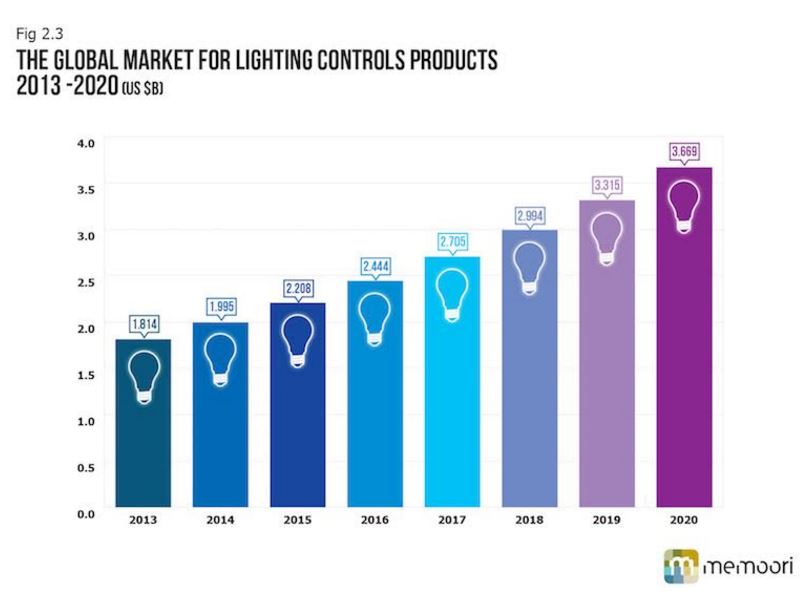|
December 2015
Article
AutomatedBuildings.com
|
[an error occurred while processing this directive]
(Click
Message to Learn More)
|
The Rules are Changing in the Global Lighting
Controls Business
Add in the potential to at last open up
the latent retrofit market and it can be seen that there are enormous
opportunities for those able to understand the various market
influences and how to exploit them.
|

Allan McHale,
Director,
Memoori |
The
rules are changing in the Lighting Controls business and using the past
to judge the future would be very misleading. The competitive landscape
is changing and companies will have to develop new strategies to grow
and capture market share.
This is just one of the findings from Memoori’s latest world report Smart Buildings: The Lighting Controls Business 2015 to
2020.

The report estimates the global value of lighting
product controls in non domestic buildings in 2015 at $2.208 billion at
factory gate prices. It also forecasts that the global market for
Lighting Controls from 2015 to 2020 will grow at a CAGR of 10.6% to
2020. Over the next five years growth in the developed markets of
Europe and North America will grow at a little more than half this rate
whilst China and Asia will exceed the average global growth.
This is indeed a high rate of growth particularly for a rather mature
lighting business where we expect unit hardware prices to fall
significantly but volume to compensate and software and value added
services to make a much larger contribution over the next five years.
So what are the changes that are
going to dramatically alter the competitive landscape and the structure
of the business?
- Changes in the Potential Value of
Lighting Control Products and the Benefits they Deliver.
- Technical Developments in both LED
Lighting, Lighting Controls and Wireless Communications.
- The Changing Landscape of the
Supply Side through Mergers, Acquisitions and Alliances and new
innovative players bringing with them new strategies to deliver the
Internet of Things in Buildings (BIoT).
The Lighting industry and many in the technical building
services industry now recognize that lighting is the most pervasive
service within a building; it reaches parts that none of the other
building services do. Combine this with the ability of solid-state
lighting to convey data through IP and for the sensors in the control
systems to gather data; there is a realization that lighting controls
are in a strong position both technically and commercially to take a
leading role in integrating most of the technical services in a
building.
Add
in the potential to at last open up the latent retrofit market and it
can be seen that there are enormous opportunities for those able to
understand the various market influences and how to exploit them.
These are just some of the subjects we discussed with
Tanuj Mohan, CTO of Enlighted in our Free Webinar last month – “Shining a Light on the Internet of Things in
Buildings; What part will Lighting Controls play in Future Smart
Buildings?”.
The report shows, through case studies, that this strategy to develop
the lighting control infrastructure to carry additional data and
functionality is already in operation; driving up the overall value of
a lighting control contract. However if Lighting Control companies are
to take advantage of this opportunity they will have to acquire new
technical skills and expand their routes to market.
[an error occurred while processing this directive]Of course this opportunity is open to other suppliers of
technical building services but if you just analyse the logistics it
would suggest that lighting and its control is a more likely core
network to build on for convergence and integration rather than
Building Energy Controls (BECS) or Plug-load. The answer lies in the
numbers – and in the ceiling. Lighting in most buildings is the second
largest energy load, but it easily represents the greatest number of
potential control points.
And when it comes
to building a reliable and scalable mesh network, the number of points
involved matters. Once a wireless lighting network is in place, adding
other devices and applications is simple – they piggyback on an
infrastructure that’s already in place.
The key difference that we have shown in the report is
that these controls applications and projects for medium and small
buildings will be lighting-centric rather than HVAC-centric and that
will make all the difference. The lighting-centric projects will be
motivated by LEDs and many will incorporate wireless and cloud
technology. This is resulting in the emergence of new players, new
technologies and new application delivery mechanisms. The existing
industry structure and business models will change dramatically over
the next five years.
footer
[an error occurred while processing this directive]
[Click Banner To Learn More]
[Home Page] [The
Automator] [About] [Subscribe
] [Contact
Us]